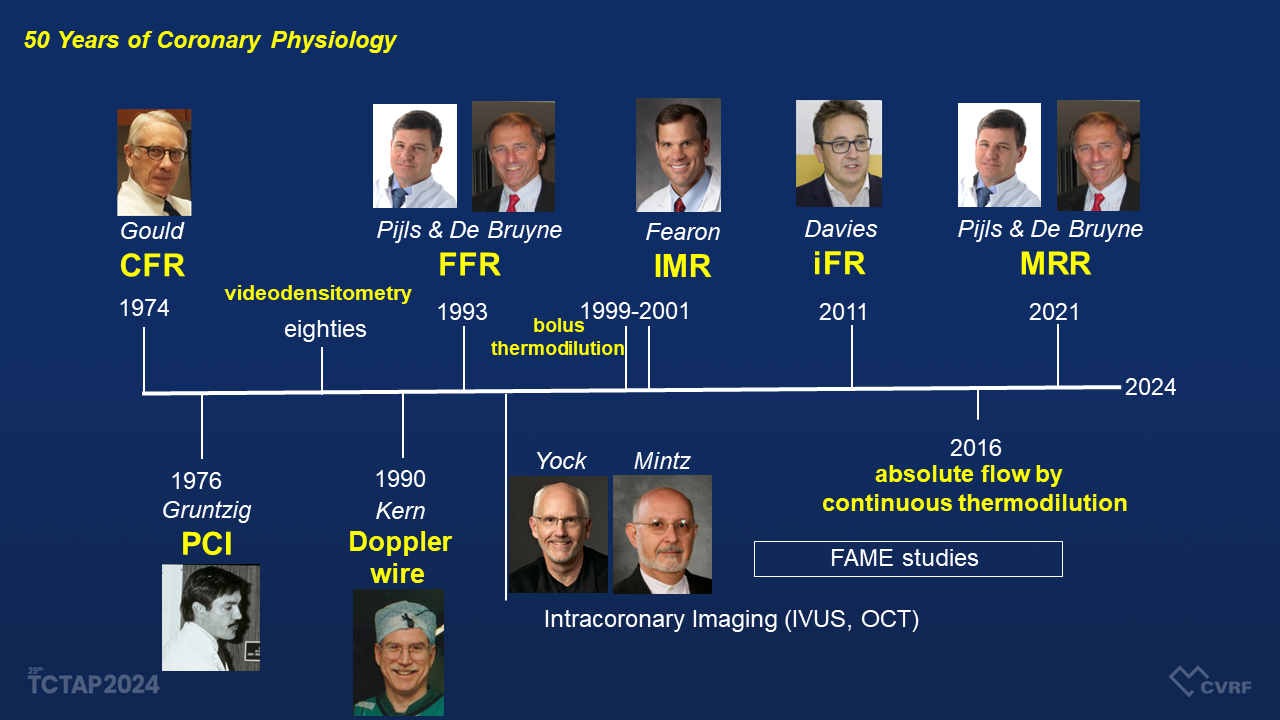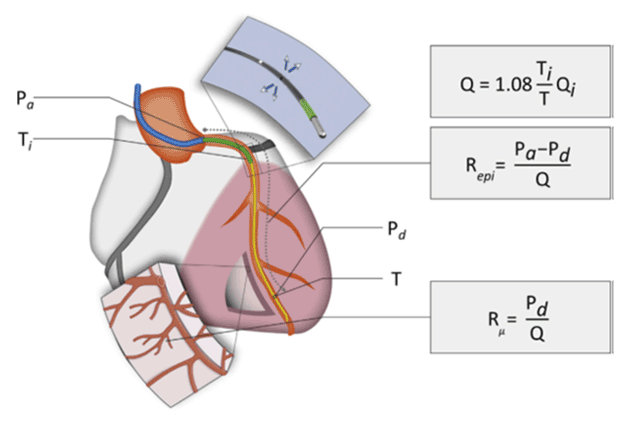News | TCTAP 2024
50 Years Long Journey of Coronary Physiology: From Humble To Great
TCTAP "Master of the Masters" Award 2024

Nico Pijls
Catharina Hospital, Netherlands
The field of coronary physiology has undergone a remarkable journey over the past half-century, evolving from rudimentary understandings to sophisticated methodologies that serve as pillars in cardiovascular medicine. Historically, research on coronary flow reserve began with Gould in 1974. Thereafter, with the study of Gruntzig's coronary angiography in 1976 and the use of Kern's Doppler wire in 1990, measurement of coronary blood flow became possible.
In the early 1990s, studies by Pijls and De Bruyne laid the experimental groundwork for modern coronary physiology. Their work elucidated the use of pressure-derived indices to assess severity of coronary stenosis, marking a significant departure from traditional angiographic assessments. Through meticulous experimentation, the feasibility of measuring fractional flow reserve (FFR) was demonstrated to evaluate the functional significance of epicardial lesions. This provided valuable physiological insights that transcended the limitations of anatomical imaging alone. These foundational studies paved the way for the widespread adoption of FFR in coronary physiology (Figure 1).
Validation of FFR as a clinical tool came to fruition through landmark trials such as the FAME (Fractional Flow Reserve Versus Angiography for Multivessel Evaluation) series. Notably, the FAME 2 trial, led by De Bruyne et al. in 2012, provided compelling evidence for the superiority of FFR-guided percutaneous coronary intervention (PCI) over medical therapy alone in patients with stable coronary artery disease (CAD). By integrating physiological assessments with routine clinical practice, FFR-guided strategies not only improved patient outcomes, but also reduced the rate of unnecessary revascularization procedures, thereby optimizing resource utilization and healthcare costs.
While FFR addressed the functional significance of epicardial stenosis, elucidating microcirculatory function emerged as a critical frontier in coronary physiology. Fearon et al. (2003) introduced the index of microcirculatory resistance (IMR), offering clinicians a comprehensive assessment of coronary physiology beyond the epicardial vessels. By quantifying the resistance within the microcirculation, IMR provided valuable insights into microvascular health and dysfunction, thereby enabling tailored therapeutic approaches in patients with suspected microvascular angina. This paradigm shift towards a more holistic understanding of coronary physiology underscored the intricate interplay between epicardial and microvascular factors within the pathophysiology of CAD, signaling a new era in precision medicine.
Innovations in coronary physiology continued to flourish with the development of adenosine-independent indices of stenosis severity. Studies by Davies (2012) introduced a novel index based on coronary wave-intensity analysis, offering a non-invasive alternative to adenosine-induced hyperemia. By leveraging intrinsic waveforms within the coronary circulation, this index provided clinicians with a robust tool for assessing the severity of lesions with enhanced accuracy and feasibility. This breakthrough not only obviated the need for adenosine administration, but also expanded the armamentarium of coronary physiology, empowering clinicians with versatile tools for tailored patient care (Figure 2).
Recent advancements in measurements of absolute coronary flow and microvascular resistance represent the pinnacle of progress in coronary physiology. Pijls and De bruyne (2021) elucidated the measurement of absolute coronary flow and microvascular resistance using thermodilution techniques, offering clinicians unprecedented insights into coronary hemodynamics. By quantifying these parameters, clinicians were able to obtain a comprehensive understanding of coronary physiology, enabling personalized treatment strategies tailored to individual patient characteristics. This shift towards precision medicine heralds a new frontier in CAD management, where therapies are tailored not only to anatomical lesions but also to physiological nuances, thereby optimizing outcomes and enhancing patient care.
The journey of coronary physiology over the past 50 years has been characterized by remarkable progress and transformative innovations. From pioneering experiments to the latest advancements, coronary physiology has evolved from a theoretical concept to a cornerstone of cardiovascular medicine. Currently, various measurements of coronary physiology provide complete and accurate description of the circulation of the heart. In the future, even further understanding of coronary physiology may be possible, through non-invasive measurements.

Figure 1. Major contributions in understanding coronary physiology

Figure 2. Physiological framework of coronary circulation
TCTAP Award
TCTAP "Master of the Masters" Award 2024
Friday, April 26, 10:10 AM ~ 10:35 AM
Main Arena, Level 2
Edited by

Se Hun Kang, MD
CHA Bundang Medical Center, Korea (Republic of)

Nico Pijls
Catharina Hospital, Netherlands
The field of coronary physiology has undergone a remarkable journey over the past half-century, evolving from rudimentary understandings to sophisticated methodologies that serve as pillars in cardiovascular medicine. Historically, research on coronary flow reserve began with Gould in 1974. Thereafter, with the study of Gruntzig's coronary angiography in 1976 and the use of Kern's Doppler wire in 1990, measurement of coronary blood flow became possible.
In the early 1990s, studies by Pijls and De Bruyne laid the experimental groundwork for modern coronary physiology. Their work elucidated the use of pressure-derived indices to assess severity of coronary stenosis, marking a significant departure from traditional angiographic assessments. Through meticulous experimentation, the feasibility of measuring fractional flow reserve (FFR) was demonstrated to evaluate the functional significance of epicardial lesions. This provided valuable physiological insights that transcended the limitations of anatomical imaging alone. These foundational studies paved the way for the widespread adoption of FFR in coronary physiology (Figure 1).
Validation of FFR as a clinical tool came to fruition through landmark trials such as the FAME (Fractional Flow Reserve Versus Angiography for Multivessel Evaluation) series. Notably, the FAME 2 trial, led by De Bruyne et al. in 2012, provided compelling evidence for the superiority of FFR-guided percutaneous coronary intervention (PCI) over medical therapy alone in patients with stable coronary artery disease (CAD). By integrating physiological assessments with routine clinical practice, FFR-guided strategies not only improved patient outcomes, but also reduced the rate of unnecessary revascularization procedures, thereby optimizing resource utilization and healthcare costs.
While FFR addressed the functional significance of epicardial stenosis, elucidating microcirculatory function emerged as a critical frontier in coronary physiology. Fearon et al. (2003) introduced the index of microcirculatory resistance (IMR), offering clinicians a comprehensive assessment of coronary physiology beyond the epicardial vessels. By quantifying the resistance within the microcirculation, IMR provided valuable insights into microvascular health and dysfunction, thereby enabling tailored therapeutic approaches in patients with suspected microvascular angina. This paradigm shift towards a more holistic understanding of coronary physiology underscored the intricate interplay between epicardial and microvascular factors within the pathophysiology of CAD, signaling a new era in precision medicine.
Innovations in coronary physiology continued to flourish with the development of adenosine-independent indices of stenosis severity. Studies by Davies (2012) introduced a novel index based on coronary wave-intensity analysis, offering a non-invasive alternative to adenosine-induced hyperemia. By leveraging intrinsic waveforms within the coronary circulation, this index provided clinicians with a robust tool for assessing the severity of lesions with enhanced accuracy and feasibility. This breakthrough not only obviated the need for adenosine administration, but also expanded the armamentarium of coronary physiology, empowering clinicians with versatile tools for tailored patient care (Figure 2).
Recent advancements in measurements of absolute coronary flow and microvascular resistance represent the pinnacle of progress in coronary physiology. Pijls and De bruyne (2021) elucidated the measurement of absolute coronary flow and microvascular resistance using thermodilution techniques, offering clinicians unprecedented insights into coronary hemodynamics. By quantifying these parameters, clinicians were able to obtain a comprehensive understanding of coronary physiology, enabling personalized treatment strategies tailored to individual patient characteristics. This shift towards precision medicine heralds a new frontier in CAD management, where therapies are tailored not only to anatomical lesions but also to physiological nuances, thereby optimizing outcomes and enhancing patient care.
The journey of coronary physiology over the past 50 years has been characterized by remarkable progress and transformative innovations. From pioneering experiments to the latest advancements, coronary physiology has evolved from a theoretical concept to a cornerstone of cardiovascular medicine. Currently, various measurements of coronary physiology provide complete and accurate description of the circulation of the heart. In the future, even further understanding of coronary physiology may be possible, through non-invasive measurements.


TCTAP Award
TCTAP "Master of the Masters" Award 2024
Friday, April 26, 10:10 AM ~ 10:35 AM
Main Arena, Level 2
Edited by

Se Hun Kang, MD
CHA Bundang Medical Center, Korea (Republic of)

Leave a comment